Sharpen kitchen knives is an essential skill for any culinary enthusiast, ensuring that your blades are always ready for the next culinary adventure. This guide will delve into the art of honing your kitchen knives, providing a detailed yet easy-to-understand approach. Keeping your knives sharp not only makes cooking more enjoyable but also enhances safety in the kitchen. Whether you’re a professional chef or a home cook, mastering this skill will elevate your cooking experience, making meal preparation smoother and more efficient. Let’s explore the world of knife sharpening, turning a mundane task into a satisfying part of your cooking routine.
What Is Knife Sharpening?
Knife sharpening is the process of re-aligning and refining the edge of a kitchen knife to restore its sharpness. This practice involves grinding the knife against a hard, abrasive surface, typically a stone or a honing rod, or using a specialized sharpening device. The primary goal is to create a keen edge that slices through food with minimal effort and precision. This process not only revives dull blades but also extends the lifespan of your knives, making it a critical skill for maintaining high-quality kitchen tools.
Why Is It Necessary?
The necessity of knife sharpening cannot be overstated. A sharp knife is a chef’s best ally in the kitchen, ensuring efficiency and precision in cutting, chopping, and slicing tasks. Dull knives, in contrast, can be hazardous; they require more force to cut, increasing the risk of the knife slipping and causing injury. Furthermore, working with a sharp knife preserves the texture and appearance of the food, ensuring clean cuts without tearing or crushing. Regular sharpening also saves money in the long run, as it prolongs the life of your knives, preventing the need for frequent replacements. In essence, sharpen your kitchen knives is a blend of safety, efficiency, and culinary excellence.
Tools For Sharpening
1. Whetstone
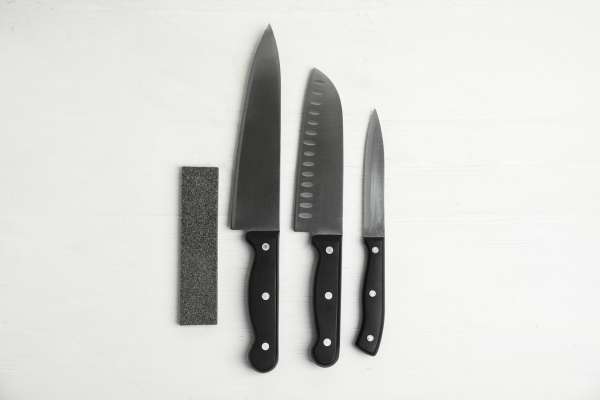
A whetstone, also known as a sharpening stone, is arguably the most effective tool for restoring sharpness to a dull blade. It comes in various grit sizes, with lower grits being coarser for repairing and reshaping edges, and higher grits finer for polishing and finishing. The process involves wetting the stone (if it’s a water stone) and sliding the blade across its surface at a consistent angle, thus grinding away the metal to form a new, sharp edge. Mastery of the whetstone technique can result in a razor-sharp blade, making it a favorite among culinary professionals.
2. Honing Steel
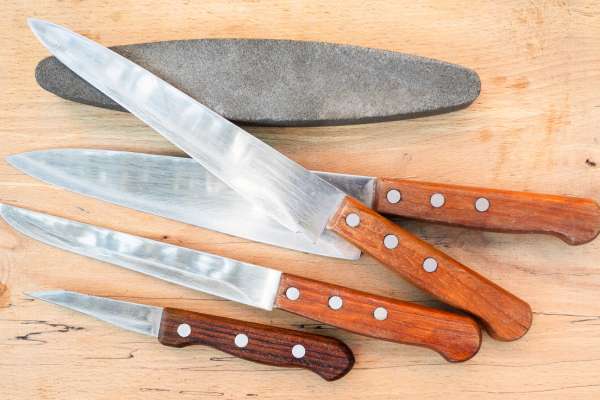
Contrary to common belief, honing steel does not actually sharpen a knife; instead, it realigns the blade’s edge. Regular use of a knife can lead to the microscopic edge of the blade bending or folding over, which makes it feel dull. Running the knife along a honing steel straightens this edge without removing significant amounts of metal. Honing should be done frequently, even after every use, to maintain the knife’s sharpness. It’s a quick, effective way to ensure the longevity of the blade’s sharpness and is an essential tool in any kitchen.
3. Electric Sharpeners
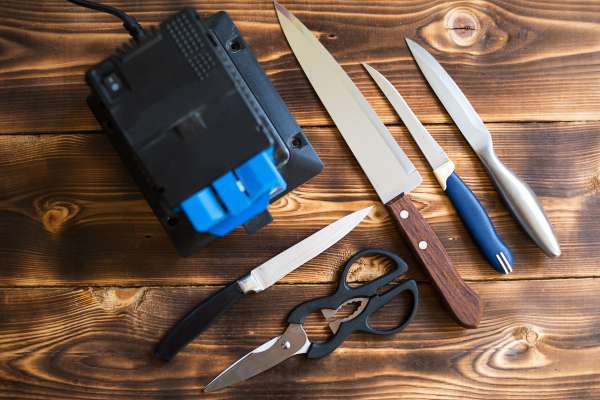
These devices are a modern, user-friendly solution for sharpening knives. Electric sharpeners typically feature one or more slots with built-in abrasive wheels that spin when powered on. To sharpen a knife, you simply need to draw the blade through these slots. The sharpener takes care of the angle and pressure, making it an excellent choice for those who are unsure about manually sharpening knives. Different models offer various stages, from coarse grinding to fine honing, catering to the needs of severely dull blades as well as regular upkeep.
4. Pull-Through Knife Sharpener
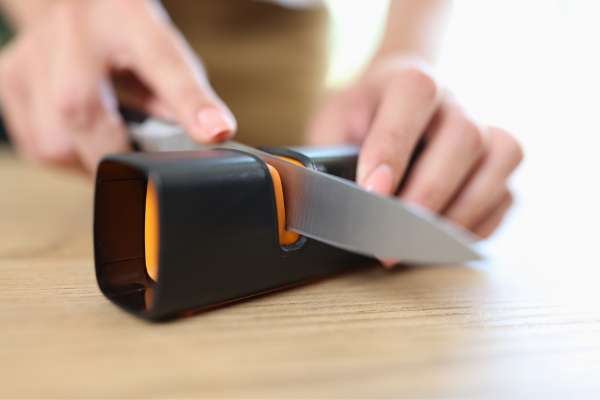
his tool is another popular choice for its simplicity and effectiveness, especially for home cooks. A pull-through sharpener generally has one or more slots fitted with fixed abrasive materials, such as ceramic or carbide. To sharpen a knife, the blade is pulled through these slots at a consistent angle. Pull-through sharpeners are compact, easy to store, and ideal for quick touch-ups. They are less aggressive than electric sharpeners and whetstones, making them suitable for regular maintenance of blades rather than restoring very dull or damaged knives.
Sharpening With A Whetstone
Preparation: Begin by soaking the whetstone in water for about 10-15 minutes (if it’s a water stone). Ensure the stone is placed on a stable surface, often using a non-slip base to prevent movement.
Finding the Angle: Hold the knife at the correct angle against the stone. This is typically around 15-20 degrees for most kitchen knives. Some whetstones come with angle guides to assist in maintaining consistency.
Sharpening Process: Gently slide the knife across the whetstone, starting from the heel and moving towards the tip in a sweeping motion. Apply consistent, light pressure, and repeat this process 5-10 times on each side of the blade.
Checking and Finishing: Frequently check the sharpness of your knife and feel for a burr (a small ridge of metal) along the edge. Once you’ve achieved a sharp edge, you can use a finer grit stone to polish and refine the blade.
Cleaning: After sharpening, clean the knife and the whetstone. This removes any metal filings and maintains the quality of the stone.
Using Honing Steel
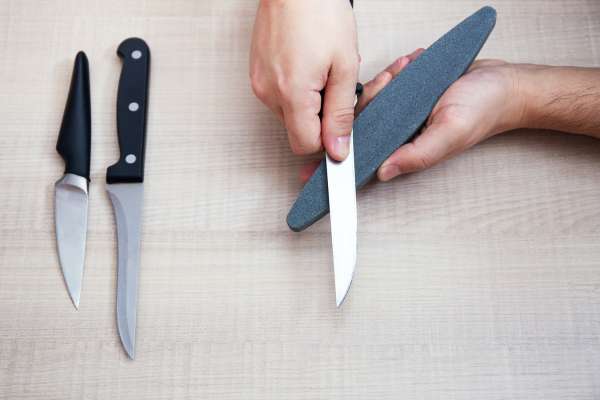
Positioning: Hold the honing steel vertically with the tip firmly placed on a non-slip surface. Grip the handle of your knife and place the heel of the blade against the top of the steel at a 15-20 degree angle.
Honing the Blade: Slide the knife down the steel, drawing it across the entire length of the blade from heel to tip. Maintain light, consistent pressure and repeat this motion 5-6 times on each side of the blade.
Regular Maintenance: Unlike sharpening with a whetstone, honing can be done more frequently, even after every use, to maintain the edge’s alignment and prevent it from becoming dull.
Safety First: Always be cautious while using honing steel, keeping your fingers away from the blade’s edge and working in a controlled manner.
Electric Knife Sharpeners:
Ease of Use: These sharpeners are designed for simplicity and efficiency. You simply turn on the device and draw your knife through the designated slots.
Multiple Sharpening Stages: Many electric sharpeners offer two or three stages for sharpening. The first stage is for grinding a new edge on dull blades, while the subsequent stages are for honing and polishing the knife.
Consistent Angle: Electric sharpeners maintain a consistent angle, a crucial aspect of sharpening. This takes the guesswork out of the process, making it ideal for those who are not confident in manually maintaining the correct angle.
Speed: Sharpening with an electric sharpener is typically faster than manual methods, making it a time-efficient choice for busy kitchens.
Caution: While convenient, electric sharpeners can remove more metal from the blade than necessary if used too frequently, potentially reducing the knife’s lifespan.
The Pull-Through Sharpener
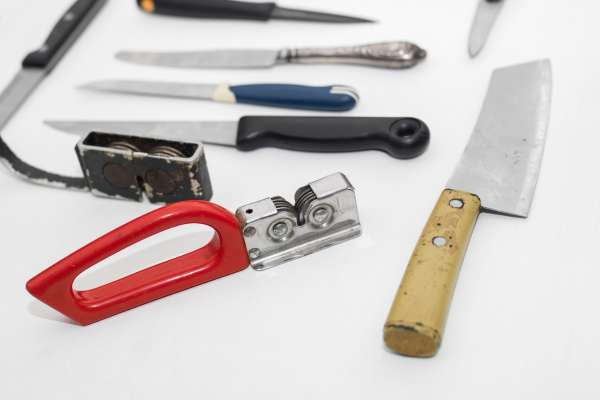
Compact and User-Friendly: Pull-through sharpeners are smaller in size, making them easy to store in kitchen drawers. Their straightforward design makes them very user-friendly.
Manual Control: Unlike electric sharpeners, they require manual control to pull the knife through the sharpener. This can be advantageous for those who prefer a more hands-on approach.
Pre-set Angles: These sharpeners have pre-set angles, ensuring a consistent edge. The simplicity of pulling the knife through the sharpener makes it accessible to beginners.
Gentler on Knives: Typically, pull-through sharpeners are gentler than electric sharpeners. They are ideal for regular maintenance and less likely to over-grind the blade.
Versatility: Many models offer different slots for coarse and fine
Can All Knives Be Sharpened?
Most kitchen knives can be sharpen, but there are exceptions. Standard chef’s knives, paring knives, and utility knives are well-suited for sharpening. However, knives with serrated edges, like bread knives, require a different sharpening approach and tools. Additionally, very cheap knives may not hold an edge well after sharpening due to lower quality metal. Extremely damaged or chipped knives might be beyond simple sharpening and could require professional restoration or replacement. It’s also important to consider the material of the blade; for instance, ceramic knives require specific types of sharpeners.
What’s The Best Angle To Sharpen A Knife?
The best angle to sharpen a knife varies depending on the type of knife and its intended use, General-purpose kitchen knives typically do well with an angle between 15 to 20 degrees per side. A more acute angle (closer to 15 degrees) results in a sharper edge, ideal for precision cutting but may require more frequent maintenance. In contrast, a slightly larger angle (around 20 degrees) provides a more durable edge suitable for heavier cutting tasks. It’s crucial to consider the manufacturer’s recommendations and the specific use of the knife when deciding on the sharpening angle.
Conclusion
while most kitchen knives can be sharpen, it’s important to recognize the exceptions and understand the specific needs of each type of knife. The choice of sharpening angle plays a significant role in the knife’s performance and longevity. Whether using a whetstone, an electric sharpener, or a pull-through sharpener, regular maintenance of your knives ensures efficient, safe, and enjoyable cooking experiences. Always approach knife sharpening with care and consideration, and when in doubt, seek professional advice or services for the best results.
